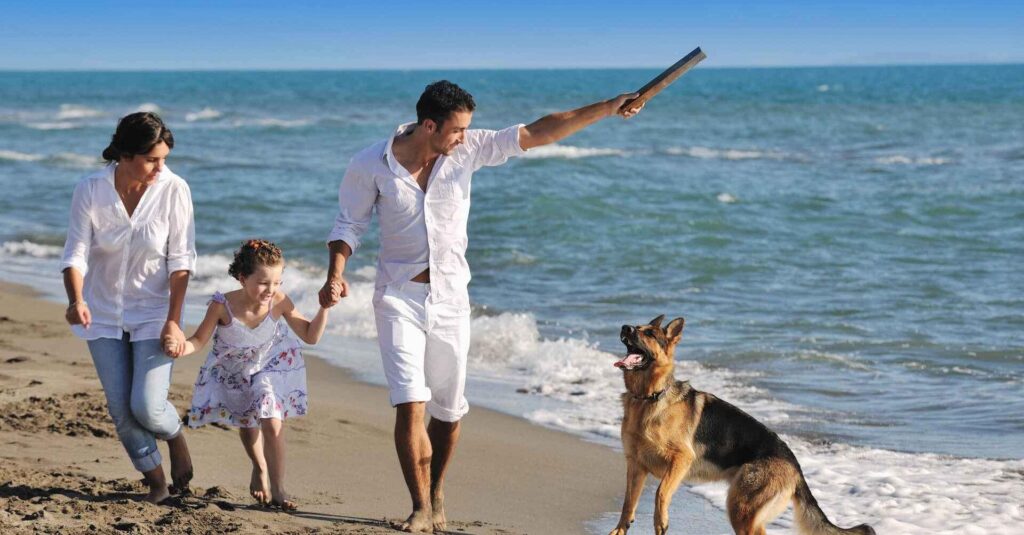As humans engage in various festive traditions to mark special occasions, one can’t help but wonder: what do our canine companions think of it all? While we may enjoy these times with our friends and family, dogs don’t understand the context or significance of these days and can get unnecessarily stressed or excited.
So regardless of whether you own an adorable breed like the Beagle or a gigantic one like a Labrador, this article is for you.
Let’s delve into the world of human holidays, visualizing them through a dog’s perspective.
A Dog’s Perspective on Human Holidays
Christmas
For many dogs, Christmas is an intriguing period. The house undergoes a vibrant transformation with twinkling lights, and there’s the peculiar practice of bringing an entire tree indoors. As these changes unfold, dogs notice their living spaces adorned with bright ornaments and feel the ambience enriched with a mix of tantalizing scents.
The aroma of cinnamon, pine, and cookies, intensified by their powerful olfactory senses, can be particularly mesmerizing.
From a dog’s viewpoint, the sudden environmental shift is both captivating and possibly overwhelming. They might be baffled by the increased activity, with family and friends frequently visiting.
To make Christmas more enjoyable for dogs, consider including them in the festivities by wrapping a toy or treat for them to unwrap. It’s also essential to ensure that the festive decorations, especially those within their reach, are secured and non-toxic.
Given the hustle and bustle, providing a calm space for dogs to retreat to can be immensely beneficial.
Halloween
Halloween is a spectacle in its own right. From a dog’s perspective, their familiar neighborhood morphs into a realm of eerie decorations. Moreover, people they’ve known their whole lives suddenly appear different, hidden behind an array of strange costumes. As the night progresses, there’s the incessant sound of the doorbell, followed by animated chatter.
This entire experience can be quite disorienting for dogs. Unable to comprehend the idea of costumes, they might perceive these disguised visitors as potential threats. To ensure their comfort, it’s helpful to keep dogs in a separate room, away from the continuous door activity. This not only prevents potential confrontations but also ensures they don’t feel the urge to escape.
Additionally, offering them familiar toys or blankets can help counteract the unfamiliarity. And, of course, keeping candies, especially chocolate which is toxic to dogs, out of their reach is paramount.
New Year’s
New Year’s is synonymous with celebrations of endings and new beginnings for humans. However, for many dogs, it might be remembered as the loudest night. Their acute hearing makes the thunderous bangs of fireworks particularly jarring. Such noises can instill fear, prompting them to seek shelter.
To ease their distress, creating a tranquil sanctuary is crucial. This could be a quiet, dimly lit room, perhaps with calming background music or white noise to mask the explosive sounds outside.
Physical presence also plays a pivotal role; staying close to them, offering gentle strokes and comforting words, can be incredibly reassuring.
Another effective approach is desensitization, where they are exposed to recorded firework sounds at progressively louder volumes over a period, rewarding calm behavior.
Dog Owners’ Universal Responsibility Across Holidays
Every festivity carries with it unique rituals, sounds, and practices. While these occasions are a source of joy for humans, they often introduce unpredictabilities to our canine companions. Consequently, the onus invariably falls on dog owners to ensure the safety and well-being of their pets, irrespective of the holiday.
Dogs, much like humans, thrive on routine and predictability. However, holidays disrupt the norm with unusual activities, unfamiliar faces, and sometimes overwhelming sounds. As caretakers, it’s imperative for dog owners to be proactive, anticipating potential sources of distress or danger for their pets.
Regular routines, such as feeding and walking, should be adhered to as closely as possible. Familiarity can serve as an anchor for pets in the midst of the unfamiliar. Likewise, introducing new items or decorations should be done with caution, ensuring they don’t pose choking hazards or contain harmful materials.
In Conclusion
Our dogs might not grasp the intricacies of our celebrations, but they’re invariably affected by the changes these events bring. As we indulge in festivities, ensuring our furry friends’ well-being becomes paramount.
Through small, considerate gestures, we can make these occasions memorable and pleasant for every family member, regardless of the number of legs they stand on.






